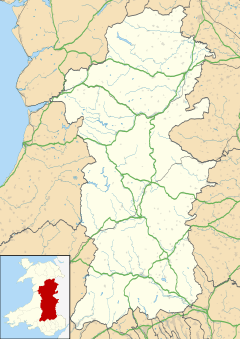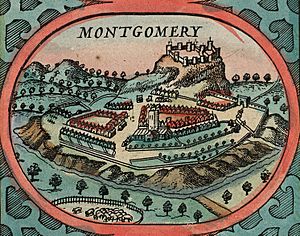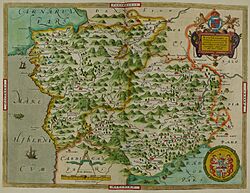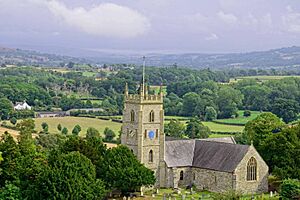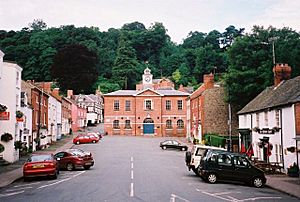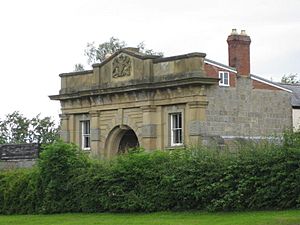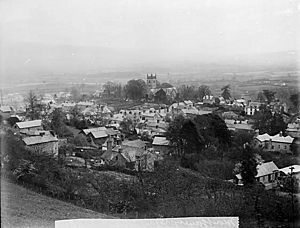Montgomery, Powys facts for kids
Quick facts for kids Montgomery
|
|
|---|---|
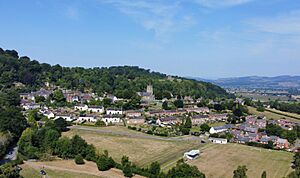 View of Montgomery with Montgomery Castle in the background |
|
| Population | 1,295 (2011 census) |
| OS grid reference | SO221967 |
| Principal area | |
| Country | Wales |
| Sovereign state | United Kingdom |
| Post town | MONTGOMERY |
| Postcode district | SY15 |
| Dialling code | 01686 |
| Police | Dyfed-Powys |
| Fire | Mid and West Wales |
| Ambulance | Welsh |
| EU Parliament | Wales |
| UK Parliament |
|
| Welsh Assembly |
|
Montgomery (which is Trefaldwyn in Welsh, meaning 'the town of Baldwin') is a town and community in Powys, Wales. It is the main town of the historic area of Montgomeryshire, which is named after it. The town is located in the Welsh Marches, an area near the border with England. The town centre is about 1 mile (1.6 km) west of the England–Wales border.
Montgomery Castle was started in 1223, and its main church began in 1227. Other interesting places in Montgomery include The Old Bell Museum, the Offa's Dyke Path, the Robber's Grave, and parts of the old town wall. A large Iron Age hill fort called Ffridd Faldwyn is found northwest of the town and west of the Castle. In 2011, the community of Montgomery had 1,295 people living there. This community also includes a place called Hen Domen.
Contents
History of Montgomery

The town of Montgomery grew around a stone castle built by the Normans. This castle was on a rocky hill at the western edge of the Vale of Montgomery. The castle was built in the early 1200s. Its purpose was to control an important crossing point over the nearby River Severn. It replaced an older wooden castle, known as a motte and bailey fort, which was located about a mile away at Hen Domen.
A powerful supporter of King William I (also known as William the Conqueror) was Roger de Montgomery. He came from a place called Montgomery in Normandy, France. King William gave him this part of the Welsh Marches. The town that grew around the castle was then named after Roger de Montgomery.
An important agreement, the Treaty of Montgomery, was signed in Montgomeryshire on September 29, 1267. In this treaty, King Henry III of England officially recognized Llywelyn ap Gruffudd as the Prince of Wales.
Later, in the early 1400s, the Welsh Prince Owain Glyndŵr attacked and looted Montgomery. At that time, the castle and its lands belonged to the Mortimer family. However, these lands became royal property when the last Earl of March died in 1425. In 1485, King Richard III lost the Battle of Bosworth. This meant that the royal lands, including Montgomery and its castle, went to the new King, Henry VII. He was the first Tudor king and was Welsh. The castle was then given to another strong Welsh family, the Herberts. A famous religious poet, George Herbert, was born in Montgomery in 1593. He was a descendant of this family.
During the English Civil War in the 1600s, the castle was taken by the Parliamentary army. After that, it was partly destroyed, or slighted, so it could no longer be used as a military threat. As a county town, Montgomery grew and its buildings give the small town its special look today.
In 1923, the Montgomeryshire County War Memorial was finished. It remembers the soldiers from Montgomeryshire who died in wars. This memorial is on a hill about 1 km southwest of the town.
Town Government
Montgomery has a Town Council that looks after local matters. There are eight town councillors who represent the community.
Until 2022, Montgomery was also an area for voting in Powys County Council elections. This area, called a ward, elected one county councillor. In 2017, Stephen Hayes won this seat.
After a review, the Montgomery ward was joined with the nearby Forden ward. This new ward, called Forden and Montgomery, has more than 2,000 people. This change happened for the 2022 elections. Jeremy Thorpe, from the Green Party, won the seat in the 2022 Powys Council election.
St Nicholas Parish Church
The main church for the area, called the parish church, was started in the 1220s. Later parts were added, including the chancel (the area around the altar) and transepts (parts that stick out from the main building) in the late 1200s. The tower was added in the 1800s. This church is a Grade I listed building, which means it's very important historically.
Some of the most amazing parts of the church are its fancy rood screen (a screen separating the nave from the chancel), misericords (small seats in the choir stalls), and stalls. These were moved to Montgomery from Chirbury Priory in Shropshire after the Dissolution of the Monasteries in the 1500s.
The south transept shows how closely the church was linked to the Herbert family. The main feature there is the tomb from the Elizabethan era for Richard Herbert (who died in 1596). He was from Montgomery Castle and was the father of the poet and church leader George Herbert.
Richard's grandson, another Richard Herbert, 2nd Baron Herbert of Chirbury, was the last Herbert to live at Montgomery Castle. He was buried in the church in 1655.
Churchyard and Robber's Grave
In 1821, a man named John Davies from Wrexham was sentenced to death by hanging in Montgomery. He was found guilty of highway robbery. During his trial and even after his sentence, Davies said he was innocent. He prayed that God would not let grass grow on his grave for a hundred years as a sign that he was telling the truth.
His grave stayed bare for at least a century, which led to the famous story of the Robber's Grave. The grave, which now has grass on it, can still be seen in the churchyard. Besides this legendary grave, the churchyard also has war graves. These are for two soldiers from World War I and one soldier and two airmen from World War II.
The Town Hall
The Montgomery Town Hall is the last remaining Georgian-style town hall in Montgomeryshire. It stands impressively at the end of Broad Street. It was built between 1748 and 1751 by William Baker of Audlem for Henry Herbert, 1st Earl of Powis. In 1828, Thomas Penson raised the roof level over the first floor. The clock tower was added in 1921. Before this building, there was likely an older, half-timbered building. A map from 1610 by John Speed shows it was located lengthwise in the middle of Broad Street.
The Old County Gaol
The old Montgomeryshire County Gaol (jail) used to stand at the end of Gaol Road. It was designed by Thomas Penson, who was the county's surveyor, and built around 1830-1832. It was made of brick with a stone front.
The jail had a tall, eight-sided house for the governor in the middle, with the chapel above it. From this central point, four wings with two or three floors spread out. One of the yards had a treadmill for prisoners to work on. The gatehouse was built into the wall in 1866 by J.W. Poundley. It looks like a strong, grand arch with large, partly rough stone pillars.
The jail was closed in 1878. Today, only the gatehouse, the Governor's House, and the high wall of one cell block remain.
Montgomery Primary School
This school was once known as the National School, built in 1864. The architect was Thomas Nicholson. The land for the school was given by Lord Powis. Money for its building came from the local Rector (a church leader) and the Hereford Diocesan Board of Education, along with many smaller donations.
The building is made of stone and has many gables (pointed roof sections) in a Gothic style. It has well-designed buttresses (supports that stick out from the walls). The master's house is on the left, the school building is on the right, and there's another wing beyond that. An assembly hall was added in 1952 by Herbert Carr, the county architect for Montgomeryshire.
The school is managed by Powys County Council and is a very important part of community life. It is still a Christian school within the diocese of St. Asaph.
The Old Bell Museum
The Old Bell Museum used to be an inn from the 1500s. It has now been changed into a museum where you can learn about the town's history.
Sport
The local football team, Montgomery Town, plays in the Ardal Leagues North East division. This is the third level of Welsh football.
Railways
The Cambrian Coast Line train route goes past the Montgomery railway station, which is currently closed.
Culture
Montgomery was used as a filming location for many parts of the 1987 TV movie based on Dylan Thomas's 'A Child's Christmas In Wales'. Famous spots like Broad Street, Church Bank, and School Bank were shown in the film.
Notable people
- The brothers George Herbert (1593-1633), a poet and church leader, Sir Henry Herbert (1594-1673), who was in charge of entertainment for the King, and Thomas Herbert (1597-1642?), a naval officer and writer, were all born in Montgomery. Their oldest brother, Edward Herbert, 1st Baron Herbert of Chirbury (1583-1648), who was a poet, philosopher, and diplomat, inherited and lived at Montgomery Castle until 1644.
- Geraint Goodwin (1903-1941), an author, lived in Montgomery until he passed away there.
- Julie Christie, a famous actress, lived for a long time near the town. She once said that the closest thing to home for her was the magical memories of a few summers she spent with her mother in Wales when she first came back from India. Because of this, she bought a simple farm near Montgomery and invited friends to stay, which is how she has lived much of her life since.
See also
 In Spanish: Montgomery (Gales) para niños
In Spanish: Montgomery (Gales) para niños


